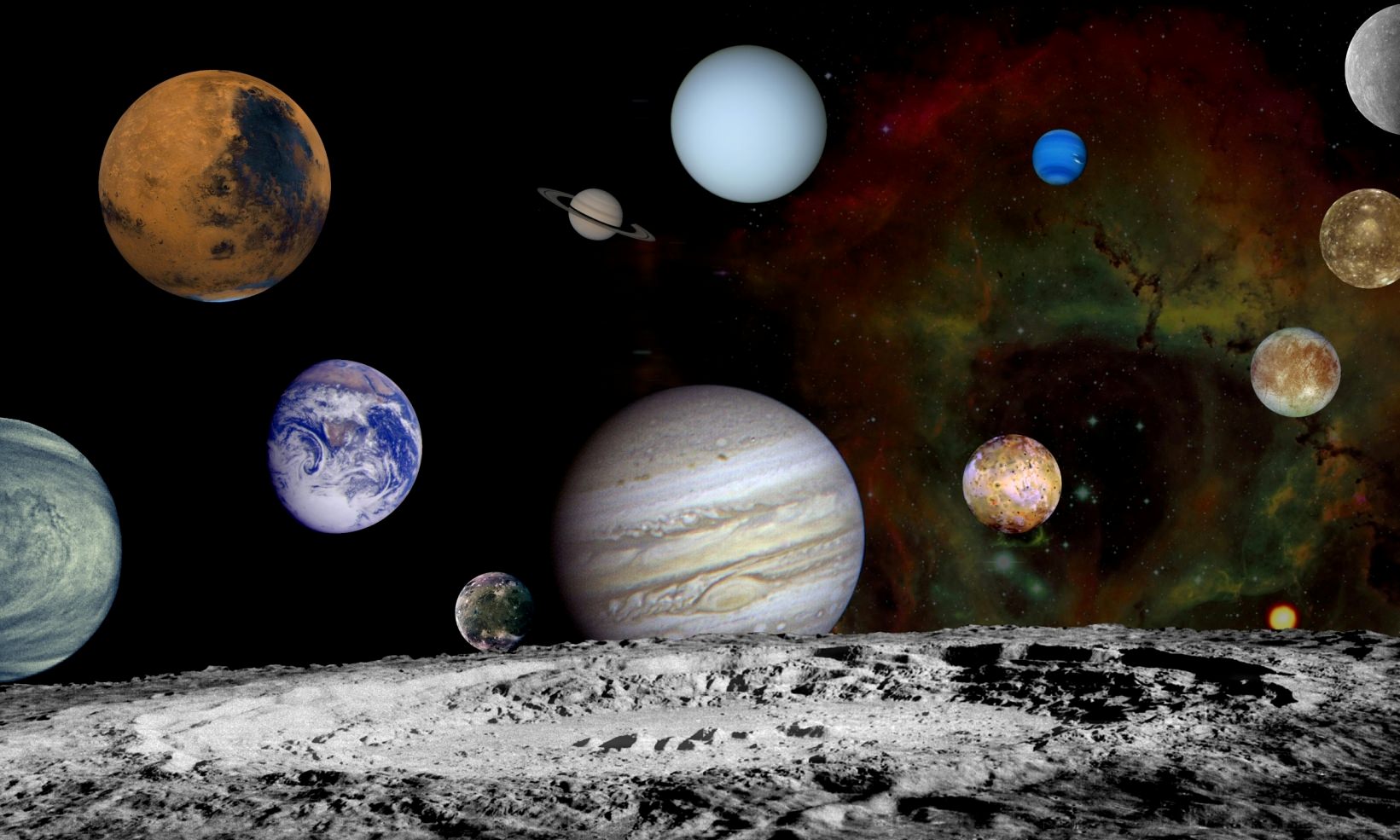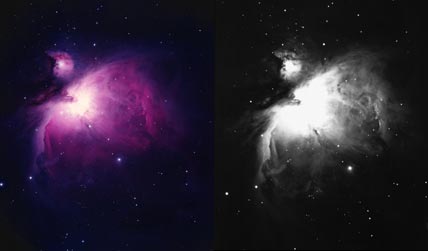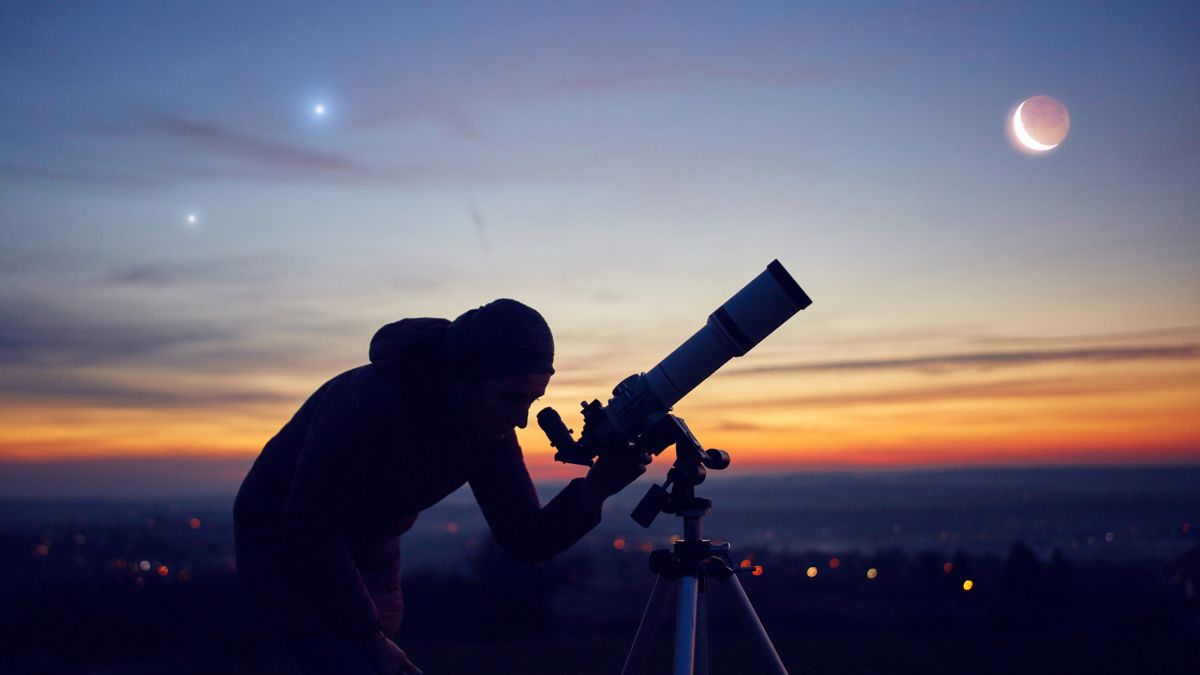Why Magnification Has a Great Influence on The Choice of Telescope
Magnification is an important consideration when choosing the best telescope for viewing planets and galaxies because it determines the apparent size of the observed objects. However, it’s crucial to understand that magnification alone is not the sole factor to consider, and there are certain limitations and trade-offs associated with using high magnification.
Here’s why magnification is important:
Apparent Size of Celestial Objects
Magnification determines how large celestial objects appear in the telescope’s eyepiece. When observing planets, increasing magnification can make them appear larger, allowing you to see finer details on their surfaces, such as cloud patterns, atmospheric bands, and planetary features. Similarly, higher magnification can also bring out more structural details in galaxies, like spiral arms and bright regions.

Example: Consider two telescopes, Telescope X and Telescope Y, each with different magnification capabilities, but the same aperture and focal length.
Telescope X: Aperture: 100mm Focal Length: 1000mm Maximum Useful Magnification: 200x
Telescope Y: Aperture: 100mm Focal Length: 1000mm Maximum Useful Magnification: 400x
Explanation:
- Magnification and Apparent Size: Magnification determines how large an object appears in the telescope’s eyepiece. A higher magnification value means the object will appear larger and more magnified. However, there’s a limit to the useful magnification based on the telescope’s aperture and atmospheric conditions (often referred to as the “maximum useful magnification”).
- Impact on Observing Planets: For observing planets, increasing magnification can be beneficial in certain cases. Let’s consider Jupiter as an example. With Telescope X (maximum 200x magnification), Jupiter will appear larger but not excessively magnified, allowing you to observe details like cloud belts and the Great Red Spot.
With Telescope Y (maximum 400x magnification), Jupiter will appear even larger, and you may see finer details on its surface. However, pushing the magnification to the maximum might not always result in a better view. Atmospheric turbulence (“seeing”) can limit the clarity and sharpness of the image at very high magnifications.
Impact on Observing Galaxies
When it comes to galaxies, high magnification might not be as important as it is for planets. Galaxies are often vast and distant objects, and higher magnification may not significantly increase their apparent size or reveal more details due to their low surface brightness.
Balancing Magnification and Aperture
While high magnification can be beneficial for certain planetary observations, a telescope’s aperture is also crucial for light-gathering power. A larger aperture allows more light to enter the telescope, making faint objects like galaxies more visible and detailed, even at lower magnifications.
Finding Objects and Tracking
Higher magnification reduces the telescope’s field of view, making it challenging to locate objects in the night sky. Additionally, at very high magnifications, keeping the object in the field of view while tracking it manually can become more difficult due to the Earth’s rotation.
Observing Details
Increasing magnification can help reveal finer details, especially on planets, giving you a more immersive observing experience. It can allow you to study intricate features and changes in planetary atmospheres over time.

Example: Consider two telescopes, Telescope A and Telescope B, each with different magnification capabilities and the same aperture and focal length.
Telescope A: Aperture: 120mm Focal Length: 1000mm Maximum Useful Magnification: 240x
Telescope B: Aperture: 120mm Focal Length: 1000mm Maximum Useful Magnification: 480x
Explanation:
- Magnification and Observing Details: Magnification plays a significant role in observing details on celestial objects, particularly planets. It determines how much the object’s apparent size is enlarged in the telescope’s eyepiece. Higher magnification can allow you to see finer features and details on planets, such as cloud patterns, atmospheric bands, and planetary moons.
- Impact on Observing Planets: With Telescope A (maximum 240x magnification), you can observe Jupiter and Saturn with a good level of detail. The cloud bands on Jupiter and the ring system of Saturn will be visible and distinguishable, providing an enjoyable observing experience.
With Telescope B (maximum 480x magnification), the planets will appear significantly larger, potentially showing finer details and features more clearly. For example, you might be able to see smaller atmospheric disturbances on Jupiter or additional divisions in Saturn’s rings.
Limitations of Very High Magnification
It’s important to be cautious about using very high magnifications, especially in telescopes with relatively smaller apertures like in this example. Atmospheric conditions can impact image stability, and at very high magnifications, the image might appear shaky or blurry due to atmospheric turbulence (“seeing”). This can reduce the overall image quality, making it challenging to observe fine details.
Finding the Optimal Magnification
The optimal magnification for observing planets is often a balance between image size and image quality. While higher magnification can reveal more details, it’s essential to find the sweet spot where the image remains steady and sharp enough for comfortable viewing.
Impact on Observing Galaxies
For observing galaxies, magnification is generally not as critical as it is for planets. Galaxies are typically large and diffuse objects, and they do not benefit as much from very high magnification. Instead, observing galaxies often relies more on the telescope’s aperture to gather enough light to reveal their structure and details.
Limitations of High Magnification
While high magnification can be beneficial for observing planets, it’s essential to recognize its limitations. Extremely high magnification might not always result in better views. Atmospheric turbulence, also known as “seeing,” can blur the image and reduce the quality of high-magnification views, especially when observing from locations with poor atmospheric conditions.

Example: Consider two telescopes, Telescope C and Telescope D, each with different aperture sizes and focal lengths, but capable of achieving high magnifications.
Telescope C: Aperture: 80mm Focal Length: 1000mm Maximum Useful Magnification: 200x
Telescope D: Aperture: 150mm Focal Length: 1200mm Maximum Useful Magnification: 300x
Explanation:
- High Magnification and Its Impact: High magnification refers to the ability to enlarge the apparent size of celestial objects when viewed through the telescope’s eyepiece. While it can be beneficial for observing certain details, particularly on planets, there are limitations to consider.
- Limitations of High Magnification: a. Atmospheric Turbulence (“Seeing”): One of the primary limitations of high magnification is atmospheric turbulence, commonly known as “seeing.” The Earth’s atmosphere is constantly in motion, causing light to bend as it passes through different layers of the atmosphere. This turbulence can distort and blur the image seen through the telescope, especially at high magnifications. As a result, the image might appear unsteady or hazy, reducing the level of detail visible.
- Aperture and Image Brightness: The aperture of a telescope determines its light-gathering ability. When using high magnification, the amount of light entering the telescope is spread over a larger area due to the increased apparent size of the object. This can lead to a dimmer image, making it more challenging to see faint details, especially in objects like galaxies, which have low surface brightness.
- Impact on Observing Planets: High magnification can be beneficial when observing planets, as it allows you to see finer details on their surfaces. With Telescope C (maximum 200x magnification), you can observe prominent features like cloud bands on Jupiter and the ring system of Saturn. Telescope D (maximum 300x magnification) would provide even more magnification, potentially revealing more intricate features on the planets.
- Finding the Optimal Magnification: To find the optimal magnification, astronomers often balance image size and image quality. Using the highest magnification might not always provide the clearest view, especially when atmospheric conditions are not ideal. It’s essential to find the sweet spot where the image remains steady and sharp enough for comfortable viewing.
- Limitations for Observing Galaxies: For observing galaxies, high magnification is generally not as critical as it is for planets. Galaxies are larger and diffuse objects, and they do not benefit as much from very high magnification. Instead, a larger aperture, like that of Telescope D, can help reveal more structural details and increase the overall brightness of the galaxy.
Balance with Aperture
Magnification should be balanced with the telescope’s aperture size. Increasing magnification beyond the practical limit of the telescope’s aperture may not yield significantly better views and could result in a dimmer image, reducing the overall image quality.

Example: Consider two telescopes, Telescope E and Telescope F, with different aperture sizes and focal lengths, but both capable of achieving high magnifications.
Telescope E: Aperture: 80mm Focal Length: 1000mm Maximum Useful Magnification: 200x
Telescope F: Aperture: 150mm Focal Length: 1200mm Maximum Useful Magnification: 300x
Explanation:
- Balance with Aperture and Magnification: When choosing a telescope for viewing planets and galaxies, it’s crucial to find the right balance between aperture and magnification. Aperture determines the telescope’s light-gathering ability, while magnification determines the apparent size of the observed objects. Striking the right balance between these two factors is essential for an optimal observing experience.
- Impact on Observing Planets: Telescope E and Telescope F can both achieve high magnifications (200x and 300x, respectively). When observing planets, higher magnification allows you to see finer details on their surfaces, such as cloud bands, atmospheric features, and planetary moons.
Telescope F, with its larger aperture, will provide better light-gathering power compared to Telescope E. This means that at the same magnification level, Telescope F can deliver brighter images, allowing for more comfortable and detailed observations of planets.
Balance for Planetary Observations
While higher magnification can be advantageous for observing planets, there’s a practical limit to the useful magnification based on the telescope’s aperture. For Telescope E, the maximum useful magnification is 200x, and for Telescope F, it is 300x.
Using magnifications beyond these limits might not necessarily yield better views. Atmospheric turbulence (“seeing”) can degrade the image quality at very high magnifications, making the view unsteady and reducing the level of detail observed.
Impact on Observing Galaxies
For observing galaxies, higher aperture size becomes more crucial than extremely high magnification. Galaxies are often large and faint objects, and a larger aperture, like that of Telescope F, will enable better light collection, resulting in brighter and more detailed views.
Finding the Right Balance
To achieve the best results when viewing planets and galaxies, it’s essential to find the right balance between aperture and magnification. High magnification is valuable for studying planetary details, but it should be used within the practical limits determined by the telescope’s aperture and atmospheric conditions.
For observing galaxies, a larger aperture like that of Telescope F will provide better results, enabling you to see more structural details and a brighter image.
Finding and Tracking Objects
High magnification reduces the field of view, making it harder to locate objects in the night sky. Additionally, it can make it more challenging to track objects as they move due to the Earth’s rotation. Smaller apertures might not provide enough light to support very high magnifications, making it difficult to achieve a satisfactory view.
![]()
Example: Consider two telescopes, Telescope G and Telescope H, each with different magnification capabilities and aperture sizes.
Telescope G: Aperture: 90mm Focal Length: 900mm Maximum Useful Magnification: 180x
Telescope H: Aperture: 150mm Focal Length: 1200mm Maximum Useful Magnification: 300x
Explanation:
- Finding and Tracking Objects: Finding and tracking celestial objects is an essential aspect of stargazing. As the magnification increases, the field of view seen through the telescope narrows, making it harder to locate objects in the night sky. Additionally, very high magnification can also make it challenging to track objects as they move due to the Earth’s rotation.
- Impact on Observing Planets and Galaxies: When observing planets, higher magnification can be beneficial as it allows you to see finer details on their surfaces. However, using excessively high magnification beyond the practical limit can make it difficult to find and track planets as they appear to move relatively quickly across the sky.
For galaxies, which are relatively large and faint objects, very high magnification might not be as critical. Instead, a larger aperture, like that of Telescope H, will enable better light-gathering, making it easier to locate faint objects like galaxies.
Field of View
The field of view is the area of the sky visible through the telescope’s eyepiece. Lower magnification, as provided by Telescope G (180x), offers a wider field of view, making it easier to locate and center objects. This is particularly helpful for beginners or when observing objects that are not easily identifiable with the naked eye.
Tracking and Stability
As magnification increases, the apparent movement of celestial objects becomes more pronounced. At very high magnifications, keeping the object centered in the field of view requires precise tracking, which might be challenging, especially if the telescope mount is not stable or equipped with tracking mechanisms.
Balance with Magnification and Aperture
To achieve a well-rounded observing experience, it’s important to consider both aperture and magnification. While higher magnification can reveal more details on planets, it should be balanced with the telescope’s aperture, which provides better light-gathering power for observing fainter objects like galaxies.
Optimal Viewing Experience
The best telescope for viewing planets and galaxies strikes a balance between aperture, magnification, and image quality. While magnification is important, having a telescope with a sufficient aperture to gather light effectively is equally essential for viewing faint objects like galaxies.

Example: Consider two telescopes, Telescope I and Telescope J, with different magnification capabilities and aperture sizes.
Telescope I: Aperture: 80mm Focal Length: 800mm Maximum Useful Magnification: 160x
Telescope J: Aperture: 150mm Focal Length: 1200mm Maximum Useful Magnification: 300x
Explanation:
- Optimal Viewing Experience: The optimal viewing experience refers to the best combination of factors that results in clear, detailed, and enjoyable observations of celestial objects. It involves finding the right balance between magnification, aperture, and other factors to ensure a satisfying stargazing experience.
- Impact of Magnification on Observations: Magnification determines the apparent size of the observed objects. Higher magnification allows you to see finer details on planets, such as cloud patterns, atmospheric bands, and planetary features. However, it is important to keep the magnification within the practical limits determined by the telescope’s aperture and atmospheric conditions.
- Impact of Aperture on Observations: Aperture plays a crucial role in light-gathering power. Telescopes with larger apertures, like Telescope J, can collect more light, providing brighter and more detailed views of both planets and galaxies. Larger apertures also offer better resolution, allowing you to see more intricate features and structures.
- The Balance between Aperture and Magnification: In this example, Telescope I has a smaller aperture and maximum useful magnification compared to Telescope J. While Telescope J provides higher magnification and light-gathering power, Telescope I is limited in both aspects.
- Finding the Right Balance: To achieve the optimal viewing experience, consider the types of celestial objects you want to observe and the conditions in your observing location. For planetary observations, both telescopes can offer enjoyable views, but Telescope J’s larger aperture will likely provide better image brightness and detail.
For observing galaxies and faint deep-sky objects, Telescope J’s larger aperture becomes more advantageous, as it can gather more light and reveal fainter objects. Telescope I might still show some galaxies, but they could appear dimmer and less detailed compared to what you can observe with Telescope J.
Other Factors
Remember that apart from aperture and magnification, other factors also impact the optimal viewing experience, such as the quality of the telescope’s optics, atmospheric conditions (“seeing”), and light pollution in your observing location.
In summary, magnification is important when choosing the best telescope for viewing planets and galaxies because it affects the apparent size and level of detail observed in celestial objects. However, it’s essential to consider magnification in conjunction with other factors, such as the telescope’s aperture, image quality, atmospheric conditions, and your observing preferences. A well-balanced approach that takes all these factors into account will ensure you have an enjoyable and rewarding stargazing experience.
